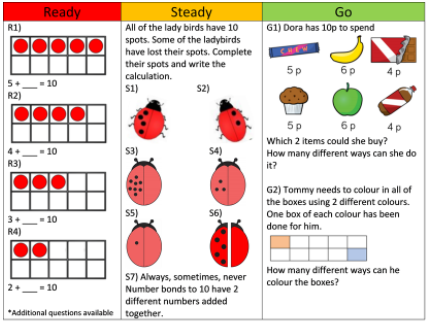Maths
Overview
Intent, Implementation and Impact
Maths Intent, Implementation and Impact
Our vision and aims for Maths:
The aims of our maths teaching are aligned with the aims of the National Curriculum: Fluency, Reasoning and Problem Solving. Children need to learn basic number facts and acquire fluency in procedures, alongside developing conceptual understanding if they are going to be able to tackle increasingly complex problems in life and later on in the workplace.
We recognise the importance of developing a ‘Growth Mindset’. We believe that all children are capable of learning maths, given sufficient time, good teaching, appropriate resources and effort. We aim to ensure that all children leave us with sound mathematical skills that will help them to realise their potential.
Our purpose of education:
We always want to provide our pupils with equal opportunities and through mathematics, we ensure that the school meets the needs of all; taking account of gender, ethnicity, culture, religion, language, age, ability, disability and social circumstances. It is important that in this school we meet the diverse needs of pupils to ensure inclusion for all and that all pupils are prepared for full participation in a multi-ethnic society. We aim to provide our pupils with a broad and balanced curriculum that is suited to the needs of all children; giving them access to the knowledge and skills needed in order for them to succeed in higher education and later life. We believe everyone can ‘do maths’ and do it well!
Curriculum content:
Year groups follow the White Rose planning. We believe that this is an effective scheme for maths as it is organised in year groups and details strategies which ensure that there is a smooth transition made for each operation from one-year group to the next. Pupils in each year group will build on their prior learning in 4 sequenced lessons each week and will have the opportunity to practise arithmetic and mental maths skills weekly. We believe this will support pupils to apply their basic mathematic skills to problem solving and reasoning questions and over the year, they will be able to include more mathematical vocabulary in their verbal and written answers.
Each maths lesson is structured to teach fluency, problem solving and reasoning skills. The children know these skills as ‘Ready, Steady and Go’.
Fluency: Fluency is knowing key mathematical facts and being able to recall them quickly and accurately. Fluency is often associated to just arithmetic questions. But for children to master fluency, they need to apply the skill they’ve learnt to different contexts and be able to choose the most suitable method for a particular problem.
Problem Solving: Problem solving is not just children answering word problems. If a child has a readily available method to answer the word problem, then no problem solving has taken place. It is about children applying their problem-solving skills to answer unfamiliar problems. For example, ‘How many ways can you find to…...?’ or ‘Circle the mistake/odd one out’.
Reasoning: Reasoning is applying logical thinking to solve which method to use and be able to explain why they have used this method. Can children explain/describe: why a particular method has been used? Or why they agree/disagree with someone else’s answer/method?
Examples of Ready, Steady, Go:





